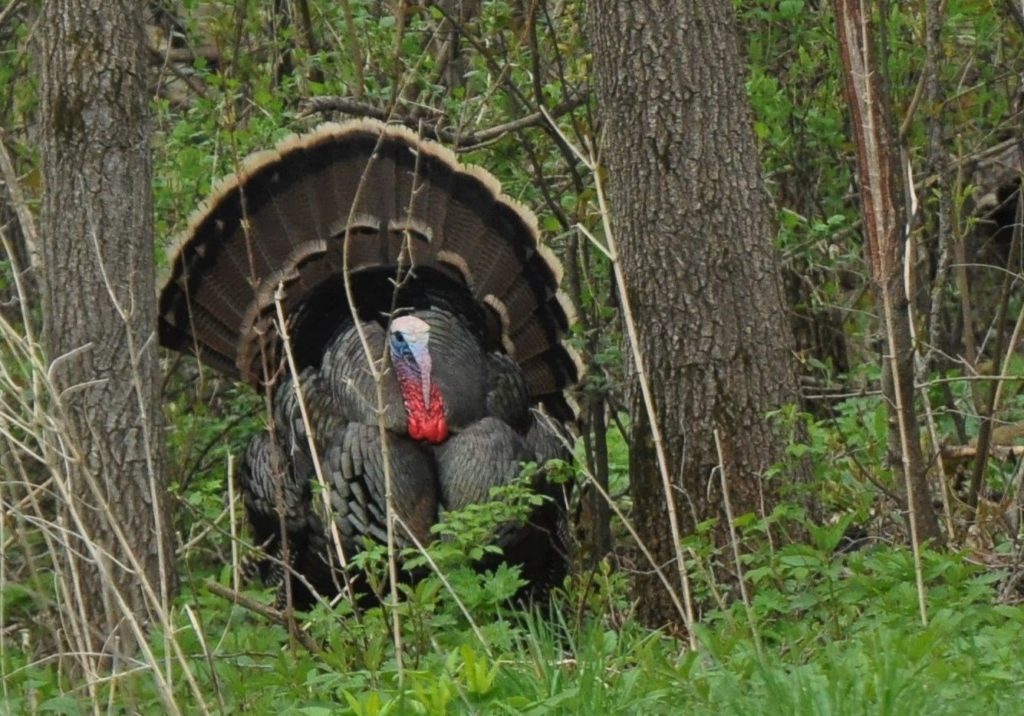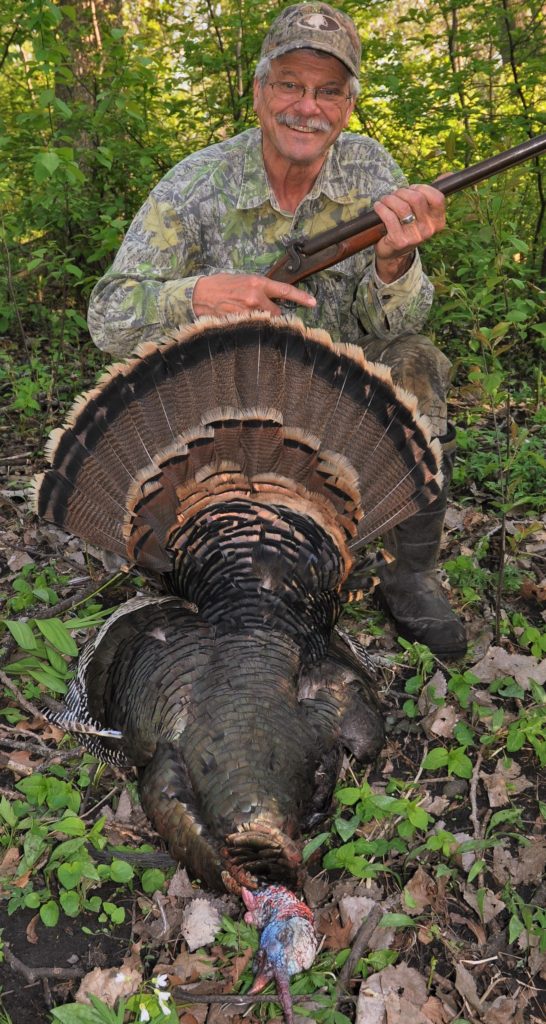Photography courtesy of Lowell Washburn, all rights reserved.
It’s been several years since I’ve killed a wild turkey with a shotgun. When I first started pursuing the birds during the late 1970s, my weapon of choice was a muzzleloading Navy Arms 12-bore. Fitted with straight cylinder bore barrels, the scattergun’s range was restricted to around 20 yards; 15 was optimum. Not exactly what you’d describe as a turkey hunter’s Dream Gun.
So why carry such an obsolete weapon? About the only answer I can come up with is that hunting with traditional black powder firearms is just plain fun. When properly stuffed with powder and shot, muzzleloading shotguns produce an impressive amount of noise, fill the air with acrid clouds of white smoke, and provide a healthy nudge to your upper torso. If I was going to be a turkey hunter, I decided that the whole forest might as well know about it when I pulled the trigger.
The late ‘70s were exciting times in the Iowa outdoors. Turkey hunting was still brand new to the state, and although most of us had attended instructional Conservation Commission sponsored turkey clinics, we knew little very little about how to successfully outwit “America’s most elusive game species”. As it turned out, the turkeys themselves were the best teachers of all. Although their lessons were often painful, they were also highly educational, and we eventually began to bag an occasional bird. Over time, I ended up bagging my first 14 turkeys with that Navy muzzleloader.

During that time, I had also developed a growing passion for archery and soon began toying with the idea of hunting turkeys with a bow. I tried it, liked it, and had soon laid the gun aside.
Although I thoroughly enjoyed hunting with longbows, I eventually got the itch to put the old muzzleloader back into action. As much as I loved the quiet solitude of the bow, I also began to miss the smoke and noise of those earlier hunts. With each passing year I thought more and more about purchasing a gun license, but then would end up buying archery tags instead. The cycle continued until this spring when I finally made up my mind to purchase a 4th season shotgun tag. After taking the muzzleloader off the shelf and blowing out the cobwebs with a test pattern – I was set to go.
May 10, 2019: Cool, calm and clear; the predawn conditions were absolutely perfect for chasing spring gobblers. Although a few fading stars were still visible, I had already located an ideal candidate for the morning’s hunt. From the east face of Red Oak Ridge, a mature gobbler was currently going completely off his rocker; issuing a near constant string of single, double and triple gobbles. As daylight slowly increased, the vocalizations only intensified. When I voiced a series of yelps, the tom nearly exploded. Once the Long Beard came out of the tree, his nonstop gobbling continued.
Things couldn’t have looked better – a completely fired up gobbler out front; no hens anywhere in sight. If things continued according to plan, it was going to be a short hunt. But things didn’t go according to plan, of course. Following another half hour of incessant gobbling, the turkey had failed to budge an inch. I was confused. If the bird had hens, why continue the intense vocalizations? If there weren’t hens, why did the revved-up tom refuse to move? Then, following a full hour on nonstop gobbling, the timber suddenly went silent. Was the bird finally on his way, I wondered. Forty-five minutes later, I was still wondering.
A quick movement caught my eye. Coming from the same direction as the gobbling, a hen was slipping by to my left. Three more hens soon passed; all coming from the same direction. It was now obvious that the morning’s prolonged gobble-fest had attracted enough hens to keep the old tom anchored in place.
While pondering what to do next, my thoughts were interrupted by the welcome sound of gobbling. Much closer than before; the tom was following his hens. Consequently, it came as no surprise when the bird refused my invitation to come to me instead. Continuing to answer my call, the old gobbler even emerged into full view before once again rejecting my pleas. Passing to my left, the tom soon grew silent again. He was with the hens.
Continuing the hunt, I managed to encounter an entertaining number of squirrels and newly arrived songbirds; but very little gobbling during the next hour and a half. There was just enough communication for me and the gobbler to keep in touch.
At 10:30, I decided to take a break. But I had barely started toward the truck when I detected a faint gobble; followed by another and then another. The sound was emanating from the exact spot where the loud-mouthed tom had begun his day. But now it seemed as if the bird’s mood had suddenly changed. Maybe it was worth one last try.
Since the bird was gobbling from an elevated vantage point, I picked the densest part of the forest to make my approach. In some spots, the gooseberries were so thick that visibility was reduced to ten or fifteen feet. By now, the gobbling had increased to an intensity that rivaled what I’d heard at first light. Using the sound as a beacon, the jungle-like understory allowed me to move quickly.
I had soon approached to within 35 yards. At this range, the gobbler seemed to be roaring. But now that I had arrived, there was no place to sit; no place where I could see farther than a few feet in any direction. Inching even closer, I found a spot offering a tunnel-like view through the thick shrubbery. Taking a seat against a ten-inch diameter tree, the location would have to do.
Meanwhile, the lathered-up gobbler was showing no signs of slacking off. Once in place, I fired off a series of yelps. The surprised tom cut me off on the second note, immediately conducting an explosive string of ear-splitting gobbles. The leaf rattling repertoire was followed by a resounding silence. The turkey was on the move.
Cocking both hammers, I slowly brought the shotgun to my shoulder. After what seemed like hours — but was probably less than two minutes — the gobbler finally sounded off again. The good news was that tom had taken the bait and was now standing a distance of 15 yards, maybe less. The bad news was that the gobble had come from behind and to my right. Even if I had been able to see the bird — which I couldn’t – turning around for a viable shot would have been impossible. If the bird kept coming, he would soon be breathing in my ear. The fantasy set up suddenly seemed doomed. Following another half dozen gobbles, the tom suddenly went silent again. Hearing no sign of alarm, I assumed the anxious bird was still trying to figure out where I was.
The nerve-racking silence continued. The suspense eventually became more than I could bear, and I decided to squeak out a couple of soft yelps. The gobbler instantly responded; still on my right but now farther to the front. Things were looking up again. A minute later, I spotted a movement through the dense foliage. The gobbler had come around to my front. Within moments, and at a distance of well under twenty yards, the elusive bird finally came into view. A second later, I had the gobbler squarely framed between the raised hammers of the Navy muzzleloader.

Knowing the precise spot where he’d last heard the unseen hen, the tom displayed no hesitation. Approaching straight on, the gobbler quickly closed the distance to a dozen paces. I think the bird would have stepped on my boot if I’d let him keep coming. Although there was still some green clutter between me and the turkey, I knew that at this range, enough of the pattern would get through to put the bird in a roaster.
I dropped the hammer, and the old front loader roared with authority. When the smoke cleared, the gobbler lay motionless, never hearing the shot that killed it. It had been a morning to remember. From start to finish, the action-packed contest had lasted for a total of six hours. Traveling full circle, the adventure ended within yards of where I’d heard the first predawn gobble.
LW


 Tom Cope
Tom Cope Sue Wilkinson
Sue Wilkinson Susan Judkins Josten
Susan Judkins Josten Rudi Roeslein
Rudi Roeslein Elyssa McFarland
Elyssa McFarland Mark Langgin
Mark Langgin Adam Janke
Adam Janke Joe Henry
Joe Henry Kristin Ashenbrenner
Kristin Ashenbrenner Joe Wilkinson
Joe Wilkinson Dr. Tammy Mildenstein
Dr. Tammy Mildenstein Sean McMahon
Sean McMahon